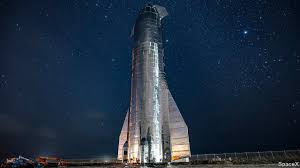It looked for all the world like something that might have graced the cover of a 1950s comic book.
它看起來(lái)就像是裝飾著20世紀(jì)50年代漫畫(huà)書(shū)的封面一樣。
On September 28th, on a warm Texas evening, Elon Musk, the boss of SpaceX, a rocketry firm,
9月28日,在德克薩斯州的一個(gè)溫暖的夜晚,火箭技術(shù)公司SpaceX的老板埃隆·馬斯克
unveiled his company's newest machine, Starship Mk1. It stands 50 metres tall and is made from shiny plates of stainless steel.
展示了他公司的最新機(jī)器——Starship Mk1。它高50米,由閃閃發(fā)光的不銹鋼板制成。
Despite its name, it is not in fact an interstellar spacecraft. But it is a prototype of an interplanetary one.
除了它的名字,它其實(shí)并不是星際飛船。但它是行星際宇宙飛船的原型。
Mr Musk hopes, one day, to use its successors to ferry passengers to the Moon or to Mars—
馬斯克希望未來(lái)能使用它的成品將乘客送往月球或火星—
or perhaps even, according to one piece of SpaceX concept art, all the way to Saturn.
或者根據(jù)SpaceX的一幅概念圖,將他們直接送往土星。
In the 17 years since its founding, SpaceX's cheap, reusable machines have revolutionised the rocket business.
自其成立以來(lái)的17年里,SpaceX廉價(jià)且可重復(fù)使用的機(jī)器徹底改變了火箭行業(yè)。
The firm's ultra-low prices have seen it grab a dominant share of the commercial satellite-launching market.
該公司的超低價(jià)格使其在商業(yè)衛(wèi)星發(fā)射市場(chǎng)占據(jù)了主導(dǎo)地位。

Along with Boeing, an American aerospace giant, SpaceX is responsible for ferrying supplies to the International Space Station.
SpaceX和美國(guó)航空業(yè)巨頭波音共同負(fù)責(zé)向國(guó)際空間站運(yùn)送物資。
It may soon fly astronauts there as well. But all of this commercial success is merely a necessary first step in Mr Musk's bigger plan,
可能很快就要運(yùn)送航天員。但所有這些商業(yè)成功僅僅是馬斯克更宏偉計(jì)劃的第一步,
which is to make humanity into a "multiplanetary species" by establishing colonies elsewhere in the solar system.
他計(jì)劃在太陽(yáng)系其他地方建立殖民地,讓人類成為“跨星球物種”。
That is where the Starship comes in. The prototype on display in Texas is only one half of an enormous rocket stack
因此就有了Starship。德克薩斯州展出的原型只是一個(gè)巨大的火箭堆的一半,
designed with planetary colonisation in mind. When paired with a Falcon Super Heavy booster,
這個(gè)火箭堆的設(shè)計(jì)考慮到了行星殖民。搭配超級(jí)重型獵鷹助推器
which is also being developed, the result should be capable of lifting around 150 tonnes into orbit.
(也在研發(fā)當(dāng)中),它應(yīng)該能夠?qū)⒓s150公噸的重量送入軌道。
That would make it the most powerful rocket ever built, squeaking ahead of the Saturn V,
這將使它成為有史以來(lái)最強(qiáng)大的火箭,超越在20世紀(jì)六七十年代
which propelled astronauts to the Moon in the 1960s and 1970s.
將宇航員送上月球的土星5號(hào)運(yùn)載火箭(Saturn V)。
And unlike the Saturn, whose three stages were abandoned to the sea or to space as their fuel was used up,
和土星5號(hào)不同的是,隨著燃料耗盡,土星5號(hào)的三個(gè)段被遺棄在了海中或太空里,
the Starship and its booster will be reusable, which should keep costs down.
而Starship及其助推器將能夠反復(fù)使用,因而降低了成本。
It is a bold plan. Mr Musk's shorter-term plans are bold too.
這是一個(gè)大膽的計(jì)劃。馬斯克的短期計(jì)劃也很大膽。
譯文由可可原創(chuàng),僅供學(xué)習(xí)交流使用,未經(jīng)許可請(qǐng)勿轉(zhuǎn)載。












